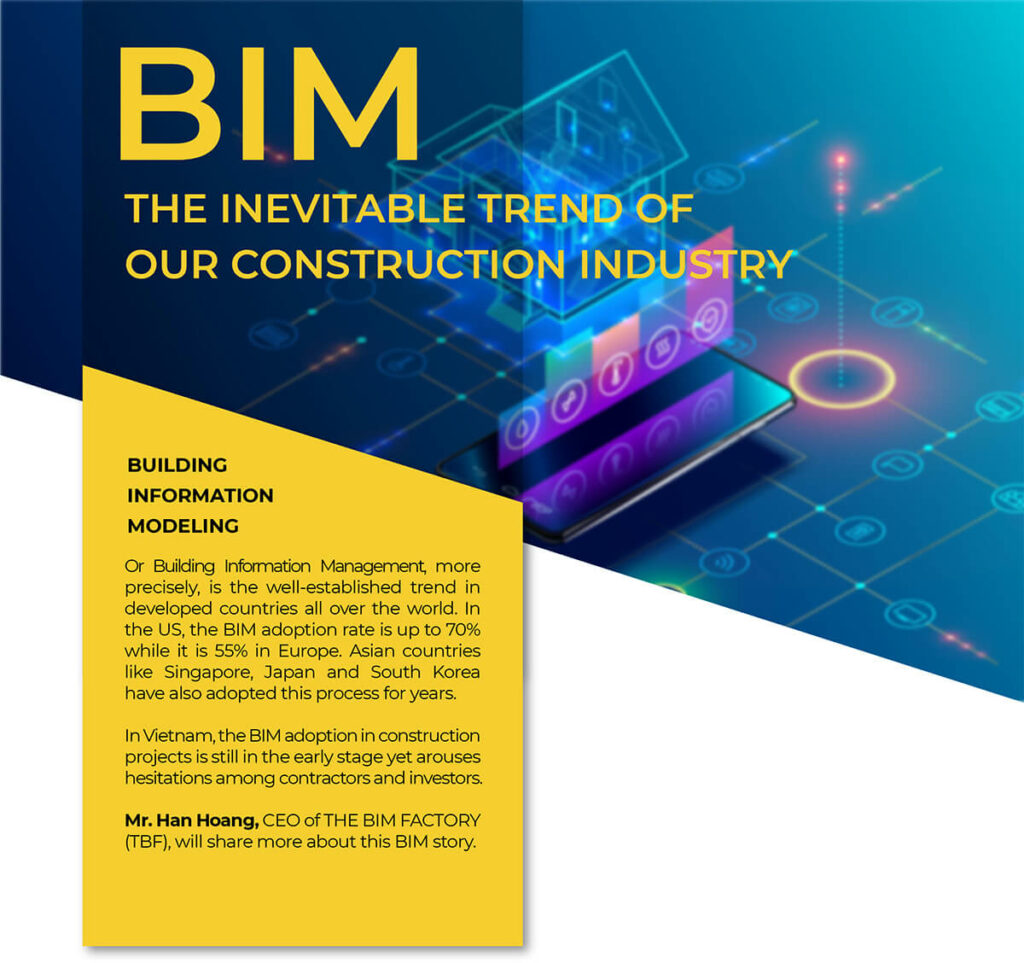BIM – THE INEVITABLE TREND OF OUR CONSTRUCTION INDUSTRY


Mr.Han: in short, BIM is the process of designing, constructing and operating a building with the use of electronic object-orientated information, i.e. Building Information Models. So from a technical perspective, I see there is not much difference: it is still the trios of investors – consultants – contractors, design – build – handover. The only but most important difference that BIM features is an open, transparent, informative and seamless communication environment. The most difficult thing that BIM requires from all the project stakeholders is to rely on that environment to understand and sympathize with each other’s needs, and co-operate toward theoverall success of the project.

Mr.Han:Because BIM is beneficial in the long run, especially the “Competitive advantages” it might bring along. Therefore, people started to do it. If the competitive advantage is the ability to streamline costs or to differentiate yourself, implementing BIM can bring both benefits, if done correctly.
Above all, the implementation of BIM is directly advantageous to design consultancy. BIM makes the change in design much simpler: the drawing will itself change according to the update of the model. The ability to coordinate multiple disciplines and automatic clash detection helps design consultants handle clashes as earliest before construction. These benefits make your design deliverables better than the market’s baseline, which is a plus point in the eyes of clients.
Moreover, design consultants will save much time and efforts developing the design if a BIM library and BIM project templates are correctly setup. This is a valuable asset of the company that can be accumulated and transferred to the next generations!
Finally, the on-cloud BIM collaboration is opening a new era of “less is more”. As long as the design team is extremely lean but elite, all the work of developing the model and design drawings can been outsourced to a BIM delivery partner. This is a trump card actively played by a few companies to get ahead of the common ground in the market. This can only be done when we know how to setup BIM implementation and design standards.

Image copyright of THE BIM FACTORY

Mr.Han: Contractors and investors can reap the most from BIM implementation, as their benefits are equivalent to the value of the project.
In Vietnam, big contractors such as Coteccons, Hoa Binh and COFICO have implemented BIM for years. BIM offers an apparent competitive advantage by promptly detecting design errors before construction, minimizing reworks, and managing quantities and costs throughout the construction process. The more complex and higher the value of the project, the more advantage BIM can bring to the contractor to save costs.
The strong BIM capacity will help contractors to participate in high requirement BIM projects of foreign investors and even international projects. Eventually, Contractors will have more confidence moving towards Design & Build once mastering the BIM process.
The project implemented BIM will have fewer design errors, and the stakeholders will be less stressed, saving a lot of time to handle any issues, RFIs raised during construction. BIM enabled contractors can save more costs, forming the basis for bids to be more competitive than ever before.
In the near future, the BIM models will integrate sensors and O&M parameters, data, especially in industrial buildings. It enables easy maintenance, manage energy consumption, reduce operating costs including energy and maintenance labor costs.

Mr.Han: In fact, there are not many technological challenges because BIM in Vietnam is still at the early stage of development, thus not taking full advantage of the capabilities of hardware and software technology. However, the main challenge comes from the industry’s misconceptions about BIM.
“BIMis Revit” is the first and oldest misconception. BIM is a process that uses multiple software, which might include Revit. But i f doing BIM is only using Revit, then Vietnam does really have a bunch of “BIM experts”.
“Implementing BIM requires hefty investments, so BIM is only for big companies”: this misconception is resulted when we think “BIM is Revit”, making the company to invest in a bunch of hardware, software and human resources to immerse into building BIM models, and must make them as detailed and complex as possible. But whether the model can be transferred to others, used for other purposes, or extracted all of their components is a difficult question.
Moreover, implementing BIM yourself without referring to proper approaches leads to the inadequate BIM capability to complete or gain benefits from BIM, while your team’s salary is still rocketing rapidly with the heat of the BIM talent market.

Image copyright of THE BIM FACTORY
“BIM is only for young people” is an interesting misconception. It is true that young people are more tech-savvy, but those seniors with industry experience are the ones who can successfully implement BIM because they know BIM is made up of 20% of technology but up to 80% of processes and most importantly, developing, coordinating and managing people.
Finally, TBF is also surprised when people misunderstand that “The BIM models will resolve the clashes themselves”. Creating a federated BIM model helps the software run clash detections and automatically generate clash analysis reports, but the software itself cannot know how to resolve clashes, which is the expertise of the design consultants instead.

Mr.Han: First of all, it is the Landmark 81 projectimplemented by Coteccons Group. Technically, this is a successful and reknown BIM project. With BIM modeling and coordination at complex structure conjunctions, this project won the 2nd prize of Tekla BIM Awards Asia 2018.
(Click here for more detail: https://vietnambim.net/du-an-bim/du-an-vinhomes- landmark-81-niem-tu-hao-cua-nguoi-viet-danh-hang-nhi-giai-thuong-tekla- bim-awards-chau-a-2018.html)
The second case is a major investor in District 7, Ho Chi Minh City implementing BIM consulted by TBF. They considered BIM since 2016 and after a lot of surveys, TBF was appointed to implement one first pilot project in 2017. At this time the design consultants were advised to use CAD and the BIM consultant will perform BIM modeling and coordination in parallel. This stage is called Hybrid BIM. Thanks to the success of the pilot project, this investor replicated the model, implementing a series of projects during the 2018 – 2019 period. After 5 projects, the design consultants have gradually implemented BIM internally, and TBF transfers to BIM project management and provides BIM modeling when needed.
Finally, there are more than 30 pilot BIM projects have been implemented with the support of the BIM Steering Committee- Ministry of Construction (MoC). Upon completion, their BIM performance will be summarized and evaluated. Contractors and investors can follow the official page of the BIM Steering Committee – MoC to update the latest information:

BIM is not only applied to high-rise buildings, but also to factory buildings. Tainan Enterprise project in Long An applied BIM, using COLORBOND® steel and steel solution from BlueScope Lysaght.

Mr. Han:With the BIM schema approved in 2016, the MoC’s roadmap to 2021 will be widely mandated in public projects. After 2023, private projects may be encouraged or mandated to adopt BIM. So we only have at least 1 year left.
So firstly, more construction projects will bedigitalized, developed more efficiently and economically than before. After completing the project, the government will own a series of BIM models to manage operations and form a premise for later smart city innitiatives, competing with other countries in national administrative capacity.
Secondly, more and more BIM-enabled design and construction companies will enhance the competitiveness of our domestic playground, creating a confidence to attract major foreign investors and participate in international projects, especially design consultancy.
If Covid-19 will be a constant in the near future, the ability to work in remote teams will create a third shift in our industry. People will have more online conference and coordinate seamlessy on the BIM model to cope with “the new normal”.

Image copyright of THE BIM FACTORY

Mr. Han: Getting started with the right mindset will help contractors save a lot of costs, time and effort invested in BIM now and in the future. Frankly speacking, you might only need a BIM Manager to set out the standards, coordinate and manage the BIM process, while BIM modeling and drawing can be done by outsourced personnel.
Second, please set realistic goals and then take small steps. BIM will be far away when we want full BIM, 6D, 7D… tomorrow morning while we have not found the actual value for customers.
After that, building a lean but competent team will be an appropriate direction if you want to maintain BIM capacity over the years.
And when you have the right mindset and resources, run a pilot project. Combine in a few small but realistic goals, the contractor will have enough time to both run the project and pay attention to BIM. Afterward, you will gain more experience to expand BIM implementation.
Finally, actively communicate with customers to raise awareness about BIM. When the Investors are well awared of BIM, your BIM professionals will have more chances to improve themselves.


